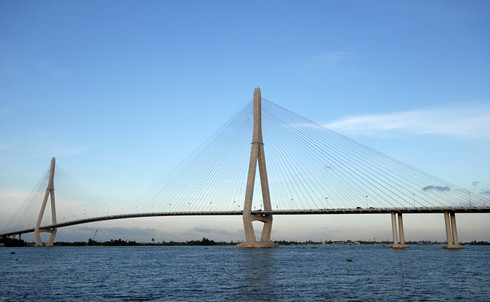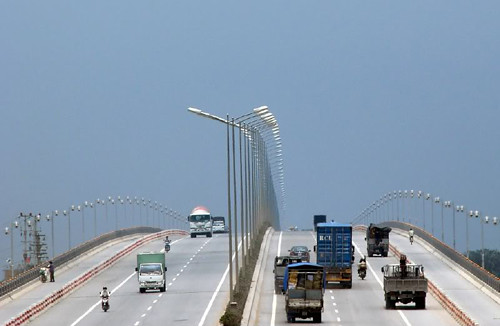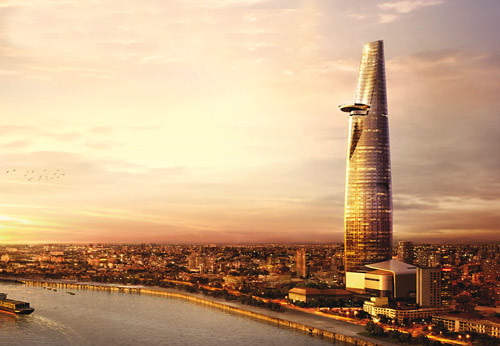VNRE - Largest cable-stayed bridge in Southeast Asia, Thang Long Avenue - the most modern country, Bitexco Financial Tower - the highest building Ho Chi Minh City, Ho Chi Minh City-Trung Luong - the first expressway for car... are the highlighted works in 2010.
1. Can Tho Bridge - the largest cable-stayed bridge in Southeast Asia

Can Tho Bridge is a bridge over the Hau River, linking Can Tho city and Vinh Long province. Currently, this is the longest cable-stayed bridge in Southeast Asia and ranked 10th in the world.
Can Tho Bridge was started on September 25th, 2004 with total cost nearly 5,000 billion VND by Japan's ODA and Vietnam's reciprocal capital. The bridge officially connected and opened on 12/10/2009, to traffic on April 24th 2010.
Can Tho Bridge has a total length of nearly 16km, 23m wide with four lanes of motor vehicles, two-lane for walk. Bridgehead belongs to Binh Minh district, Vinh Long and the end of Cai Rang district, Can Tho city.
2. Thang Long Avenue - The most modern and longest avenue in Vietnam

Thang Long Avenue begins from the intersection Pham Hung Road, passing through areas of Tu Liem, Hoai Duc, Quoc Oai, Thach That (Hanoi) to the intersection Highway 21- Ho Chi Minh road.
The avenue was constructed on March 20th 2005 and inaugurated on October 3rd 2010, on the occasion of celebration of 1,000 years of Thang Long-Hanoi. This not only is the longest avenue, but also is the first standard expressway in Vietnam was put to use.
Thang Long Avenue is a componetn project in the Lang-Hoa Lac road project, with total investment of 7,527 billion VND. This is a modern highway, total length of 29.264 km, cross-section width of 140m, including six separate lanes (two collector roads, two highways, two tunnels ), 12 overpass bridges.
Buffer zone along both sides of the avenue are green trees with minimum width is 200 meters on each side.
3. Ho Chi Minh City-Trung Luong Highway - the first highway only for car

Ho Chi Minh City-Trung Luong Highway project has total length of 61.9 km, design speed 120km/h, the total investment cost of 10,000 billion VND. The construction was started on December 16th 2004 and inaugurated on February 3rd 2010.
The highway was designed eight-lane, viaduct segments, has no same level intersection with other roads. The highway is linking Ho Chi Minh City with Tien Giang Province, this is a part of the Ho Chi Minh City-Can Tho highway.
This highway meets for about 50,000 vehicles crossing every day. With Ho Chi Minh City-Trung Luong Highway, time for moving from Ho Chi Minh City to Tien Giang has been shortened to only about 30 minutes, instead of 90 minutes before.
4. Vinh Tuy Bridge - Vietnam's largest bridge

One of the seven bridges crossing the Red River in Hanoi, Vinh Tuy bridge is linking Long Bien district and Hai Ba Trung with investment fund is nearly 3,600 billion VND. The bridge was started on February 3rd 2005 and inaugurated on September 26th 2010.
This is the first bridge by Hanoi city own investment and construction. The bridge has eight spans of bridge. The entire main bridge is 19m wide and viaduct bridge long 5.8 km were made by consultants, engineers, workers of Vietnam.
Vinh Tuy bridge was put into use will contribute to shorten the route from downtown to Highway 5 to Hai Phong, Quang Ninh about 3km, loss of pressure for Chuong Duong Bridge.
Hanoi People's Committee also decided to invest Phase 2 (started from August 2010) enlarge the surface of Vinh Tuy bridge to 38m.
5. Bitexco Financial Tower - the highest tower in Ho Chi Minh City

The 68-storey tower in downtown Ho Chi Minh City is considered the highest building in the city, ranked second in the country, is constructed by steel and glass, total imvestment of more than 5,000 billion VND. The building was started construction in 2005 and inaugurated on October 31th 2010.
The tower reproduces graceful image of lotus bud, which is considered a symbol for dynamic of Ho Chi Minh City in economic integration period.
This building provides 37,000 m2 of office and 8,000 m2 of commercial, with a helicopter parking on floor 50th and a modern elevator system has speed of 7m/second. The uppermost of the building is decorated, lighted lamps at night to create stunning beauty such as lighthouse of the city.
6. Hanoi Museum - new and unique museum

Hanoi museum was built on area of 53.963m2 located in the National Convention Center campus, adjacent Pham Hung Road. Two buildings constitute the uninterrupted architectural community, beautiful scenery in the West Hanoi.
Hanoi Museum has a total floor area of over 30.000m2, was constructed on May 19th 2008 and inaugurated on October 6th 2010.
The museum was designed by reverse pyramid, with four storeys and two basements, each floor reachs out 5m compared to adjacent floors below, in which Floor 4 has the largest area and area of floors below is smaller. The museum's height is 30.7m, is considered the most impressive museum in Vietnam.
Hanoi Museum became a place of storage and display thousands of artifacts, cultural heritages which reflects the development of Hanoi capital over times.
In particular, in the main lobby of the museum store a letter to future generations, will be opened after 100 years.
Source: VNA
1. Can Tho Bridge - the largest cable-stayed bridge in Southeast Asia

Can Tho Bridge is a bridge over the Hau River, linking Can Tho city and Vinh Long province. Currently, this is the longest cable-stayed bridge in Southeast Asia and ranked 10th in the world.
Can Tho Bridge was started on September 25th, 2004 with total cost nearly 5,000 billion VND by Japan's ODA and Vietnam's reciprocal capital. The bridge officially connected and opened on 12/10/2009, to traffic on April 24th 2010.
Can Tho Bridge has a total length of nearly 16km, 23m wide with four lanes of motor vehicles, two-lane for walk. Bridgehead belongs to Binh Minh district, Vinh Long and the end of Cai Rang district, Can Tho city.
2. Thang Long Avenue - The most modern and longest avenue in Vietnam

Thang Long Avenue begins from the intersection Pham Hung Road, passing through areas of Tu Liem, Hoai Duc, Quoc Oai, Thach That (Hanoi) to the intersection Highway 21- Ho Chi Minh road.
The avenue was constructed on March 20th 2005 and inaugurated on October 3rd 2010, on the occasion of celebration of 1,000 years of Thang Long-Hanoi. This not only is the longest avenue, but also is the first standard expressway in Vietnam was put to use.
Thang Long Avenue is a componetn project in the Lang-Hoa Lac road project, with total investment of 7,527 billion VND. This is a modern highway, total length of 29.264 km, cross-section width of 140m, including six separate lanes (two collector roads, two highways, two tunnels ), 12 overpass bridges.
Buffer zone along both sides of the avenue are green trees with minimum width is 200 meters on each side.
3. Ho Chi Minh City-Trung Luong Highway - the first highway only for car

Ho Chi Minh City-Trung Luong Highway project has total length of 61.9 km, design speed 120km/h, the total investment cost of 10,000 billion VND. The construction was started on December 16th 2004 and inaugurated on February 3rd 2010.
The highway was designed eight-lane, viaduct segments, has no same level intersection with other roads. The highway is linking Ho Chi Minh City with Tien Giang Province, this is a part of the Ho Chi Minh City-Can Tho highway.
This highway meets for about 50,000 vehicles crossing every day. With Ho Chi Minh City-Trung Luong Highway, time for moving from Ho Chi Minh City to Tien Giang has been shortened to only about 30 minutes, instead of 90 minutes before.
4. Vinh Tuy Bridge - Vietnam's largest bridge

One of the seven bridges crossing the Red River in Hanoi, Vinh Tuy bridge is linking Long Bien district and Hai Ba Trung with investment fund is nearly 3,600 billion VND. The bridge was started on February 3rd 2005 and inaugurated on September 26th 2010.
This is the first bridge by Hanoi city own investment and construction. The bridge has eight spans of bridge. The entire main bridge is 19m wide and viaduct bridge long 5.8 km were made by consultants, engineers, workers of Vietnam.
Vinh Tuy bridge was put into use will contribute to shorten the route from downtown to Highway 5 to Hai Phong, Quang Ninh about 3km, loss of pressure for Chuong Duong Bridge.
Hanoi People's Committee also decided to invest Phase 2 (started from August 2010) enlarge the surface of Vinh Tuy bridge to 38m.
5. Bitexco Financial Tower - the highest tower in Ho Chi Minh City

The 68-storey tower in downtown Ho Chi Minh City is considered the highest building in the city, ranked second in the country, is constructed by steel and glass, total imvestment of more than 5,000 billion VND. The building was started construction in 2005 and inaugurated on October 31th 2010.
The tower reproduces graceful image of lotus bud, which is considered a symbol for dynamic of Ho Chi Minh City in economic integration period.
This building provides 37,000 m2 of office and 8,000 m2 of commercial, with a helicopter parking on floor 50th and a modern elevator system has speed of 7m/second. The uppermost of the building is decorated, lighted lamps at night to create stunning beauty such as lighthouse of the city.
6. Hanoi Museum - new and unique museum

Hanoi museum was built on area of 53.963m2 located in the National Convention Center campus, adjacent Pham Hung Road. Two buildings constitute the uninterrupted architectural community, beautiful scenery in the West Hanoi.
Hanoi Museum has a total floor area of over 30.000m2, was constructed on May 19th 2008 and inaugurated on October 6th 2010.
The museum was designed by reverse pyramid, with four storeys and two basements, each floor reachs out 5m compared to adjacent floors below, in which Floor 4 has the largest area and area of floors below is smaller. The museum's height is 30.7m, is considered the most impressive museum in Vietnam.
Hanoi Museum became a place of storage and display thousands of artifacts, cultural heritages which reflects the development of Hanoi capital over times.
In particular, in the main lobby of the museum store a letter to future generations, will be opened after 100 years.
Source: VNA

Post a Comment
Post a Comment